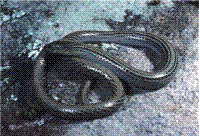Family
Pygopodidae (legless lizards)
Genus
Delma
Species
impar
Threats/Control Methods - Regional
The main threats to the Striped Legless Lizard are the further loss of grassland habitat due to development and intensive farming activity.
Threats/Control Methods - Local
In suburban Canberra, loss of habitat due to urban development and domestic animals are the greatest threats to the species' survival.
Local/Urban Actions
Three nature reserves have been established to safeguard the grassland habitat in the Gungahlin area. Some other areas of the ACT where the species lives have had Memorandums of Understanding put in place, which will help maintain the current habitat that the lizards require to survive.
Common name/s
Striped Legless Lizard, Spinifex Snake Lizard
Distinguishing Features
The Striped Legless Lizard has (not surprisingly) no legs, but is a lizard and not a snake. It has a blunt snout and a yellowish brown stripe along its back to the tip of the tail. Dark and light stripes (or rows of spots) are found along its body, with these stripes being less distinct on the tail. Juveniles usually do not feature any stripes or other markings.
Similar Species
The Olive Legless Lizard (Delma inornata ) is similar in appearance, but lacks stripes or distinct patterning. Legless lizards are often mistaken for snakes and are sometimes killed as a result. However, the two species of legless lizards in the ACT do not resemble any snakes in the area. Legless lizards have a fleshy tongue and ear openings, while snakes have forked tongues and no ear holes or flaps.
Distribution
Southern NSW around ACT, central and western Vic and into SA. Locally found in four discrete areas: Gungahlin, the lower Majura Valley, the lower Jerrabomberra Valley and Yarramundi Reach.
Country of Origin
Australia
Survey Techniques
Pitfall trapping is currently used to survey the species.
Conservation (Pet/Pest) Status - National
Conservation (Pet/Pest) Status - Regional
Vulnerable (Nature Conservation Act 1980)
LSCCES Population
The local population has become fragmented by urban development and infrastructure. It is likely that further habitat will be lost due to urban expansion.
Associated vegetation community
Grasslands
Limiting Resources
The abundance of Delma impar is dependant on Lepidoptera (butterflies and moths) larvae. The lizard also requires grassland habitat, usually of native grasses, but can also live in areas dominated by introduced grass species.
Breeding
Delma impar reaches maturity at around 3 years. The female lays a clutch of two eggs in early summer, with the eggs hatching one to two months later.
Behaviour
Tends to shelter under rocks, fallen vegetation and in tussock grasses. The lizard also shelters in burrows. It is active from late Spring to early Autumn and is diurnal. As with other lizards, it likes to bask in the sun to until very warm.
Functional Group
Insectivore
Food Species
The lizard eats a variety of insects including caterpillars, wolf spiders, crickets, grasshoppers and cockroaches.
Predators
Foxes (Vulpes vulpes) and cats (Felis domesticus).
Interesting Fact
This legless lizard species squeaks loudly when in distress.
Legless lizards are closely related to geckos.
References - (reader suitability of references, P=Primary teachers, S=Secondary students, T=Tertiary students and researchers)
Books:
Bennett, R. 1997. Reptiles & Frogs of the Australian Capital Territory, National Parks Association of the ACT, Woden. P, S
Wilson, S and Knowles, D. 1988. Australia's reptiles, Collins Publishers, Australia. S
Internet:
Department of the Environment and Heritage. 2007. "Delma impar" in Species Profile and Threats Database. Department of the Environment and Heritage, Canberra.http://www.environment.gov.au/cgi-bin/sprat/public/publicspecies.pl?taxon_id=1649 S, T
Online Publications:
ACT Government. 1997. Striped Legless Lizard (Delma impar): A vulnerable species. Action Plan No. 2. Environment ACT, Canberra.http://www.environment.act.gov.au/__data/assets/pdf_file/13836/actionplans2.pdf S, T
Researchers: Ian Rayner and Adam Houlden


 Top
Top Top
Top